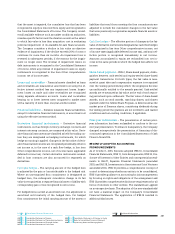Siemens 2014 Annual Report Download - page 262
Download and view the complete annual report
Please find page 262 of the 2014 Siemens annual report below. You can navigate through the pages in the report by either clicking on the pages listed below, or by using the keyword search tool below to find specific information within the annual report.
108 A. To our Shareholders 131 B. Corporate Governance 171 C. Combined Management Report
As of October , , Siemens adopted IFRS , Fair Value
Measurement. The new standard defines fair value and
standardizes disclosures on fair value measurements of both
financial and non-financial instrument items. The standard
is applied on a prospective basis. The adoption of IFRS did
not have a material impact on the Company’s Consolidated
Financial Statements.
RECENT ACCOUNTING PRONOUNCEMENTS,
NOT YET ADOPTED
The following pronouncements, issued by the IASB, are not yet
effective and have not yet been adopted by the Company:
In July , the IASB completed its project to replace IAS ,
Financial Instruments: Recognition and Measurement by pub-
lishing the final version of IFRS : Financial Instruments. IFRS
introduces a single approach for the classification and measure-
ment of financial assets according to their cash flow character-
istics and the business model they are managed in, and pro-
vides a new impairment model based on expected credit losses.
IFRS also includes new regulations regarding the application
of hedge accounting to better reflect an entity’s risk manage-
ment activities especially with regard to managing non-finan-
cial risks. The new standard is effective for annual reporting
periods beginning on or after January , , while early
application is permitted. The European Financial Reporting
Ad visory Group postponed its endorsement advice on IFRS .
The Company is currently assessing the impacts of adopting
IFRS on the Company’s Consolidated Financial Statements.
In May , the IASB issued IFRS , Revenue from Contracts
with Customers. According to the new standard, revenue is rec-
ognized to depict the transfer of promised goods or services to
a customer in an amount that reflects the consideration to
which the Company expects to be entitled in exchange for
those goods or services. Revenue is recognized when, or as,
the customer obtains control of the goods or services. IFRS
also includes guidance on the presentation of contract bal-
ances, that is, assets and liabilities arising from contracts with
customers, depending on the relationship between the entity’s
performance and the customer’s payment. In addition, the new
standard requires a set of quantitative and qualitative disclo-
sures to enable users of the Company’s Consolidated Financial
Statements to understand the nature, amount, timing, and un-
certainty of revenue and cash flows arising from contracts with
customers. IFRS supersedes IAS , Construction Contracts
and IAS , Revenue as well as related interpretations. The
standard is effective for annual periods beginning on or after
January , ; early application is permitted. The Company
is currently assessing the impact of adopting IFRS on the
Company’s Consolidated Financial Statements and will deter-
mine the adoption date as well as the transition method.
NOTE Critical accounting estimates
Siemens’ Consolidated Financial Statements are prepared in
accordance with IFRS as issued by the IASB and as adopted by
the EU. Siemens’ significant accounting policies, as described
in NOTE SUMMARY OF SIGNIFICANT ACCOUNTING POLICIES are
essential to understanding the Company’s results of operations,
financial positions and cash flows. Certain of these accounting
policies require critical accounting estimates that involve com-
plex and subjective judgments and the use of assumptions,
some of which may be for matters that are inherently uncertain
and susceptible to change. Such critical accounting estimates
could change from period to period and have a material impact
on the Company’s results of operations, financial positions and
cash flows. Critical accounting estimates could also involve
estimates where management reasonably could have used a
different estimate in the current accounting period. Manage-
ment cautions that future events often vary from forecasts and
that estimates routinely require adjustment.
Revenue recognition on construction contracts – The
Company’s Sectors, particularly Energy, Industry and Infra-
structure & Cities, conduct a significant portion of their
business under construction contracts with customers.
The Company accounts for construction projects using the
percentage- of- completion method, recognizing revenue as
performance on contract progresses. Certain long-term ser-
vice contracts are accounted for under the percentage-of-
completion method as well. This method places considerable
importance on accurate estimates of the extent of progress
towards completion and may involve estimates on the scope
of deliveries and services required for fulfilling the contractu-
ally defined obligations. These significant estimates include
total contract costs, total contract revenues, contract risks,
including technical, political and regulatory risks, and other
judgments. Under the percentage-of-completion method,
changes in estimates may lead to an increase or decrease of
revenue. The creditworthiness of our customers is taken into
account in estimating the probability that economic benefits
associated with a contract will flow to the Company. In addi-
tion, we need to assess whether the contract is expected to
continue or to be terminated. In determining whether the con-
tinuation or termination of a contract is expected to be the
most likely scenario, all relevant facts and circumstances relat-
ing to the contract are considered on an individual basis. For
contracts expected to be continued, amounts already included
in revenue for which collectability ceases to be probable are
recognized as an expense. For contracts expected to be termi-
nated, including terminations due to expected payment de-
faults of our customers or terminations due to force majeure
events, the estimates on the scope of deliveries and services
provided under the contracts are revised accordingly, typically
























